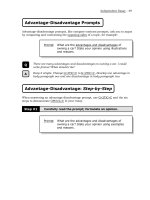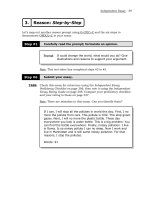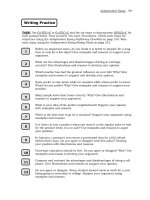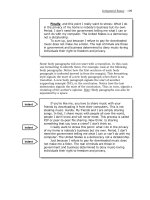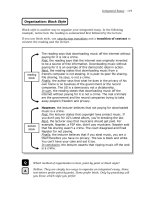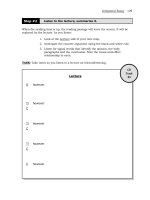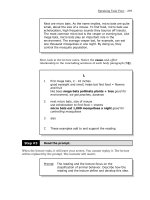Guidance on Technica Audits and Related Assessments for Environmental Data Operations EPA QA/G-7 doc
Bạn đang xem bản rút gọn của tài liệu. Xem và tải ngay bản đầy đủ của tài liệu tại đây (254.04 KB, 101 trang )
Quality
United States
Environmental Protection
Agency
Guidance on Technical
Audits and Related
Assessments for
Environmental Data
Operations
EPA QA/G-7
Final
Office of Environmental
Information
Washington, DC 20460
EPA/600/R-99/080
January 2000
Final
EPA QA/G-7 January 2000i
FOREWORD
The U.S. Environmental Protection Agency (EPA) has developed several types of
technical audits and related assessments as important tools for the systematic and objective
examination of a project to determine whether environmental data collection activities and related
results
• comply with the project’s quality assurance project plan,
• are implemented effectively, and
• are suitable to achieve data quality goals.
The mandatory Agency-wide Quality System requires that all organizations performing work for
EPA develop and operate management processes and structures for ensuring that data or
information collected are of the needed and expected quality for their desired use. Technical
audits and related assessments are an integral part of the fundamental principles of quality
management that form the foundation of the Agency’s Quality System.
This document is one of the U.S. Environmental Protection Agency Quality System Series
requirements and guidance documents. These documents describe the EPA policies and
procedures for planning, implementing, and assessing the effectiveness of the Quality System.
Questions regarding this document or other Quality System Series documents may be obtained
from the Quality Staff:
U.S. EPA
Quality Staff (2811R)
Office of Environmental Information
Ariel Rios Building
1200 Pennsylvania Avenue, NW
Washington, DC 20460
Phone: (202) 564-6830
Fax: (202) 565-2441
email:
Copies of the EPA Quality System Series may be obtained from the Quality Staff or by
downloading them from the Quality Staff Home Page:
www.epa.gov/quality
Final
EPA QA/G-7 January 2000ii
Final
EPA QA/G-7 January 2000iii
TABLE OF CONTENTS
Page
CHAPTER 1. INTRODUCTION 1
1.1 PURPOSE AND OVERVIEW 1
1.2 THE EPA QUALITY SYSTEM 2
1.3 SCOPE AND BACKGROUND 3
1.4 INTENDED AUDIENCE 7
1.5 SPECIFIC DEFINITIONS 7
1.6 PERIOD OF APPLICABILITY 8
1.7 ORGANIZATION OF THE DOCUMENT 9
CHAPTER 2. USING TECHNICAL AUDITS AND RELATED ASSESSMENTS 11
2.1 WHAT IS A TECHNICAL AUDIT OR ASSESSMENT? 11
2.1.1 General Characteristics of Technical Audits and Assessments 11
2.1.2 Self-Assessments versus Independent Audits and Assessments 12
2.1.3 Role of Technical Audits and Assessments in the EPA Quality
System 13
2.2 WHY CONDUCT A TECHNICAL AUDIT OR ASSESSMENT? 13
2.3 AUTHORITY TO AUDIT OR ASSESS 15
2.4 ATTRIBUTES OF AUDITORS 17
2.4.1 Education and Training 18
2.4.2 Independence and Objectivity 19
2.4.3 Experience 19
2.4.4 Personal Attributes of Auditors 20
2.5 MANAGEMENT OF AUDIT PROGRAMS 21
2.6 AUDIT COSTS 21
2.6.1 Budget 21
2.6.2 Cost Considerations 22
CHAPTER 3. STEPS IN THE GENERAL TECHNICAL AUDIT AND ASSESSMENT
PROCESS 23
3.1 PLANNING 23
3.1.1 Decision to Conduct an Audit 23
3.1.2 Selection of Audit Type 25
3.1.3 Selection of Audit Team 25
3.1.4 Planning Meeting 26
3.1.5 Confidentiality and Dissemination of Audit Results 27
3.1.6 Review of Project Documents 29
3.1.7 Contact with Auditee 30
3.1.8 Audit Plan and Other Preparation 33
3.1.9 Audit Questionnaire 36
3.1.10 Audit Checklist 36
TABLE OF CONTENTS (continued)
Page
Final
EPA QA/G-7 January 2000iv
3.2 PERFORMANCE OF THE AUDIT 38
3.2.1 Audit Protocol 38
3.2.2 Opening Meeting 40
3.2.3 Audit Activities 41
3.2.4 Observation of Work 43
3.2.5 Interviews 43
3.2.6 Document Review 45
3.2.7 Objective Evidence Compilation 46
3.2.8 Closing Meeting 46
3.3 EVALUATION 48
3.3.1 Identification of Finding 48
3.3.2 Evaluation of Finding 49
3.4 DOCUMENTATION 50
3.4.1 Draft Finding Report 51
3.4.2 Final Report 52
3.5 CORRECTIVE ACTION 54
3.6 CLOSEOUT 55
CHAPTER 4. TYPES OF TECHNICAL AUDITS 57
4.1 INTRODUCTION TO AUDIT TYPES 57
4.2 READINESS REVIEWS 57
4.3 TECHNICAL SYSTEMS AUDITS 59
4.4 SURVEILLANCE 62
4.5 PERFORMANCE EVALUATIONS 63
CHAPTER 5. RELATED TECHNICAL ASSESSMENTS 67
5.1 INTRODUCTION TO ASSESSMENT TYPES 67
5.2 AUDITS OF DATA QUALITY 67
5.3 DATA QUALITY ASSESSMENTS 68
CHAPTER 6. GUIDANCE FOR AUDITEES 71
6.1 PREAUDITS PARTICIPATION 71
6.2 AUDIT READINESS 72
6.3 AUDIT PARTICIPATION 72
6.3.1 Opening Meeting 72
6.3.2 Audit Activities 73
6.3.3 Closing Meeting 73
6.4 DRAFT FINDINGS REPORT REVIEW 74
6.5 CONFIDENTIALITY AND DISSEMINATION OF AUDIT RESULTS 74
TABLE OF CONTENTS (continued)
Page
Final
EPA QA/G-7 January 2000v
REFERENCES AND SUPPLEMENTAL INFORMATION SOURCES 75
APPENDIX A. GLOSSARY A-1
APPENDIX B. EXAMPLE OF A TECHNICAL SYSTEMS AUDIT CHECKLIST B-1
Final
EPA QA/G-7 January 2000vi
LIST OF FIGURES
Page
Figure 1. EPA Quality System Components 4
Figure 2. A Generalized Flowchart of a Technical Audit 24
Figure 3. Example of an Audit Plan 28
Figure 4. Suggested Format for the Notification Letter 31
Figure 5. Suggested Format for the Follow-up Letter 32
Figure 6. Example of a Technical Audit Agenda 34
Figure 7. Example of a Logistical Letter 35
Figure 8. Characteristics of an Opening Meeting 41
Figure 9. Interviewing Considerations and Techniques 44
Figure 10. Characteristics of an Closing Meeting 47
Figure 11. Types of Findings 49
Figure 12. Example Draft Findings Report Format 52
Figure 13. Example of a Draft Findings Report Transmittal Letter 53
Figure 14. Example of a Closeout Letter 56
Figure 15. Example of a Flowchart of Technical Systems Audit Implementation 60
Final
EPA QA/G-7 January 2000
1
CHAPTER 1
INTRODUCTION
1.1 PURPOSE AND OVERVIEW
This document provides general guidance for selecting and performing technical audits
and related assessments of environmental data operations. The document also provides guidance
on the general principles of audits and assessments from the context of environmental programs
associated with the U.S. Environmental Protection Agency (EPA). Such environmental programs
include:
• intramural programs performed by EPA organizations,
• programs performed under EPA extramural agreements [i.e., contracts, grants,
cooperative agreements, and interagency agreements (IAGs)], and
• programs required by environmental regulations, permits, and enforcement
agreements and settlements.
This guidance is nonmandatory and is intended to help organizations plan, conduct, evaluate, and
document technical audits and related assessments for their programs. It contains tips, advice,
and case studies to help users develop processes for conducting technical audits and related
assessments. Because of the diversity of environmental programs that may use one or more of the
technical audits and assessments described, it is not possible to provide all of the implementation
details in this document. Additional guidance has been developed for some “tools” and other
guidance is likely. The user is referred to those documents for additional information.
Establishing and implementing an effective assessment program are integral parts of a
quality system. Audits and assessments, both management and technical, provide management
with the needed information to evaluate and improve an organization’s operation, including:
• the organizational progress in reaching strategic goals and objectives,
• the adequacy and implementation of management or technical programs developed
to achieve the mission,
• the quality of products and services, and
• the degree of compliance with contractual and regulatory requirements.
Final
EPA QA/G-7 January 2000
2
1.2 THE EPA QUALITY SYSTEM
A quality system is a structured and documented management system describing the
policies, objectives, principles, organizational authority, responsibilities, accountability, and
implementation plan of an organization for ensuring quality in its work processes, products, and
services. A quality system provides the framework for planning, implementing, documenting, and
assessing work performed by the organization for carrying out required quality assurance (QA)
and quality control (QC) activities. Audits and assessments are an integral part of a quality
system.
Since 1979, EPA policy has required participation in an Agency-wide quality system by all
EPA organizations (i.e., offices, regions, national centers, and laboratories) supporting intramural
environmental programs and by non-EPA organizations performing work funded by EPA through
extramural agreements. The EPA Quality System operates under the authority of Order 5360.1
CHG 1, Policy and Program Requirements for the Mandatory Agency-wide Quality System (U.S.
EPA, 1998c), hereafter referred to as the Order. The implementation requirements for the Order
for EPA organizations are provided in Order 5360, EPA Quality Manual for Environmental
Programs (U.S. EPA, 1998a). The Order and applicable extramural agreement regulations define
EPA’s authority to conduct technical audits and assessments.
The Order requires every EPA organization collecting and using environmental data to
document its quality system in an approved quality management plan and requires QA Project
Plans for all environmental data collection be developed, reviewed, approved, and then
implemented as approved, before work commences. The Order defines environmental data as any
measurement or information that describes environmental processes, locations, or conditions;
ecological or health effects and consequences; or the performance of environmental technology.
For EPA, environmental data include information collected directly from measurements, produced
from models, and compiled from other sources such as databases or the existing literature. The
Order applies (but is not limited) to the following environmental programs:
• the characterization of environmental or ecological systems and the health of
human populations;
• the direct measurement of environmental conditions or releases, including sample
collection, analysis, evaluation, and reporting of environmental data;
• the use of environmental data collected for other purposes or from other sources
(also termed “secondary data”), including literature, industry surveys, compilations
from computerized databases and information systems, and results from
computerized or mathematical models or environmental processes and conditions;
and
Final
EPA QA/G-7 January 2000
3
• the collection and use of environmental data pertaining to the occupational health
and safety of personnel in EPA facilities (e.g., indoor air quality measurements)
and in the field (e.g., chemical dosimetry, radiation dosimetry).
EPA bases its quality system on the American National Standard for quality systems in
environmental programs, ANSI/ASQC E4-1994, Specifications and Guidelines for Quality
Systems for Environmental Data Collection and Environmental Technology Programs (ASQ,
1994), developed by the American National Standards Institute (ANSI) and American Society for
Quality (ASQ). Non-EPA quality systems that demonstrate objective evidence of conformance to
ANSI/ASQC E4-1994 also are in compliance with EPA policy.
The EPA Quality System comprises three structural levels: policy, organization/program,
and project (see Figure 1). This structure promotes consistency among quality systems at the
higher management levels, while allowing project managers the flexibility necessary to adapt the
EPA Quality System components to meet the individual and often unique needs of their work.
The EPA Quality System encompasses many functions, including the following:
• establishing quality management policies and guidelines for the development of
organization- and project-specific quality plans;
• establishing criteria and guidelines for planning, implementing, documenting, and
assessing activities to obtain sufficient and adequate data quality;
• providing an information focal point for QA and QC concepts and practices;
• performing management and technical audits or assessments to ascertain the
effectiveness of QA and QC implementation; and
• identifying and developing training programs related to QA and QC
implementation.
The EPA Quality System also is characterized by the principle of “graded approach,”
which allows managers to base the degree of quality controls applied to an organizational area or
project on the intended use of the results and on the confidence that is needed and expected in the
quality of the results.
1.3 SCOPE AND BACKGROUND
A technical audit or assessment is a systematic and objective examination of a program or
project to determine whether environmental data collection activities and related results comply
with the project’s QA Project Plan and other planning documents, are implemented effectively,
and are suitable to achieve its data quality goals. Technical audits and assessments may also be
used as an investigative tool where problems may be suspected. A technical audit or assessment
Final
EPA QA/G-7 January 2000
4
ORGANIZATION/PROGRAM
PROJECT
POLICY
Defensible Products and Decisions
EPA Program &
Regional Policy
External Policies
Contracts - 48 CFR 46
Assistance Agreements -
40 CFR 30, 31, and 35
Internal EPA Policies
EPA Order 5360.1
EPA Manual 5360
Consensus Standards
ANSI/ASQC E4
ISO 9000 Series
Annual Review
and Planning
Systems
Assessments
Quality System
Documentation
Training/CommunicationSupporting System Elements
Technical
Assessments
IMPLEMENTATIONPLANNING ASSESSMENT
Conduct Study/
Experiment
QA
Project Plan
Systematic
Planning
Standard
Operating
Procedures
Data Quality
Assessment
Data Verification
& Validation
Figure 1. EPA Quality System Components
Final
EPA QA/G-7 January 2000
5
is not a management assessment (e.g., the management systems review process, which is used to
conduct quality system audits, and which occurs at the organization/program level) nor is it data
verification/validation, which occurs during the assessment phase of the project. However, in
certain circumstances, a technical audit or assessment may be performed with or as an adjunct to a
management assessment.
Technical audits and assessments are conducted as part of an organization’s quality
system. They are dependent on other components of the system, including effective planning and
QA documentation like the QA Project Plan, to guide and provide evaluation or performance
criteria for them. The absence of one or more components, such as an approved QA Project Plan,
may limit the effectiveness of audits and assessments. In most cases, the QA Project Plan will be
the basis for planning and conducting the technical audits and assessments, although other
planning documentation also may be used. There also must be clear designated authority for
conducting the audits and assessments and for confirming implementation of any corrective
actions taken from them.
While most audits and assessments will be scheduled in advance with an organization,
there may be occasions when unannounced technical audits or assessments are needed. Such
needs are identified in planning and are usually based on historical evidence of problems.
Unannounced audits and assessments are particularly effective in getting the “true” picture of
project implementation. However, there are downsides to unannounced audits. For example, a
visit may occur during a period when the project is not active or when project staff are very busy
with routine project activities that would be disrupted by an unannounced audit. In either case,
the unannounced audit or assessment may not reveal a representative picture of project activities.
Several types of technical audits and related assessments can be used to evaluate the
effectiveness of project implementation, as follows:
• Readiness reviews are conducted before specific technical activities (e.g., sample
collection, field work, and laboratory analysis) are initiated to assess whether
procedures, personnel, equipment, and facilities are ready for environmental data
to be collected according to the QA Project Plan.
• Technical systems audits (TSAs) qualitatively document the degree to which the
procedures and processes specified in the approved QA Project Plan are being
implemented.
• Surveillance is used to continuously or periodically assess the real-time
implementation of an activity or activities to determine conformance to established
procedures and protocols.
Final
EPA QA/G-7 January 2000
6
• Performance evaluations (PEs) quantitatively test the ability of a measurement
system to obtain acceptable results.
• Audits of data quality (ADQs) are conducted on verified data to document the
capability of a project’s data management system (hardcopy and/or electronic) to
collect, analyze, interpret, and report data as specified in the QA Project Plan.
• Data quality assessments (DQAs) are scientific and statistical evaluations of
validated data to determine if the data are of the right type, quality, and quantity to
support their intended use.
Technical audits are discussed in greater detail in Chapter 4 and related assessments are discussed
in Chapter 5.
Because they accomplish different objectives, different types of audits and assessments
often can be integrated into one effort, depending on the needs of the project. For instance, a PE
can quantitatively indicate a problem with the bias of a measurement system and a TSA can
determine the cause of the problem. Some of these types of audits and assessments (i.e., TSAs,
readiness reviews, and surveillance) are primarily conducted at the project site. Other types of
audits and assessments (i.e., PEs, ADQs, and DQAs) are primarily conducted away from the
project site, but may have a component for gathering objective evidence or for delivering a PE
sample at the project site.
For the purposes of this document, inspection is not included as a technical audit or
assessment. The International Organization for Standardization defines inspection as “an activity
such as measuring, examining, testing, or gauging one or more characteristics of an entity and
comparing the results with specified requirements in order to establish whether conformance is
achieved for each characteristic” (International Organization for Standardization, 1994d). This
definition suggests that inspection is part of routine quality control practices that may be supplied
to an operation. While several of the audit and assessment types discussed in this document
involve elements of inspection, they are more specific in their scope and application than the more
general term, inspection, and are used in this document instead.
Peer reviews may be used along with other technical audits and assessments to
corroborate scientific defensibility. A peer review is a documented critical review of a specific
major scientific and/or technical work product. It is conducted by qualified individuals (or
organizations) independent of those who performed the work but which are collectively
equivalent in technical expertise (i.e., peers) to those who performed the original work. A peer
review is an in-depth assessment of the assumptions, calculations, extrapolations, alternative
interpretations, methodology, acceptance criteria, and conclusions pertaining to the specific
scientific and/or technical work products and of the documentation that supports them.
Final
EPA QA/G-7 January 2000
7
EPA conducts peer reviews of major scientifically and technically based work products
used to support its decisions. Additionally, they are used by EPA to evaluate applications for
research assistance agreements, graduate fellowships, and environmental research centers. More
generally, peer reviews are used in the academic community to evaluate the quality of research
publications. Despite the widespread use of peer reviews, they are outside the scope of this
document. Guidance for EPA peer reviews is given in EPA’s Peer Review Handbook (U.S. EPA,
1998b).
1.4 INTENDED AUDIENCE
This document is intended primarily for organizations conducting technical audits and
related assessments for environmental programs associated with EPA. Such organizations include
EPA itself since the Agency collects environmental data through a variety of intramural activities.
Environmental data are collected by other organizations through extramural agreements with
EPA, including State program grants, contracts, cooperative agreements, grants, and interagency
agency agreements. EPA quality requirements apply to regulatory activities including permits,
enforcement consent orders and agreements, and enforcement settlements when included in the
applicable agreement.
As noted earlier, this document provides general guidance for selecting and performing
technical audits and related assessments of environmental data operations. The document also
provides guidance on the general principles of audits and assessments from the context of
environmental programs associated with EPA and includes a section on expectations from the
perspective of the organization being assessed.
While this guidance is general, its application and use is not confined to environmental
programs associated with EPA, but may be used by any organization implementing environmental
programs.
1.5 SPECIFIC DEFINITIONS
For purposes of consistency, the following terms are used throughout this document.
These definitions do not constitute the Agency’s official use of terms for regulatory purposes and
should not be construed to alter or supplant other terms in use.
1. EPA QA Manager: The EPA QA Manager, or the person assigned equivalent duties,
responsible for ensuring the implementation of the organization’s quality system as defined
by the project’s approved QMP. The QA Manager should:
• function independently of direct environmental data generation, model
development, or technology development;
Final
EPA QA/G-7 January 2000
8
• report on quality issues to the senior manager with executive leadership authority
for the organization; and
• have sufficient technical and management expertise and authority to independently
oversee and implement the organization’s quality system in the environmental
programs of the organization.
2. Project QA Manager: The project QA Manager, or the person assigned equivalent
duties, responsible for ensuring the implementation of the QA and QC procedures and
activities defined in the project’s approved QA Project Plan.
3. Client: Any individual or organization for whom items or services are furnished or work
is performed in response to defined requirements and expectations.
4. Quality Assurance Project Plan: A formal planning document for an environmental
data collection operation that describes the data collection procedures and the necessary
QA and QC activities that must be implemented to ensure that the results are sufficient
and adequate to satisfy the stated performance criteria. A QA Project Plan documents the
outputs of the systematic planning process and the resulting sampling design. It is the
blueprint for identifying how the quality system of the organization performing the work is
reflected in a particular project and in associated technical goals. It also details the
management authorities, personnel, schedule, policies, and procedures for the data
collection. Often, QA Project Plans incorporate or cite standard operating procedures,
which help to ensure that data are collected consistently using approved protocols and
quality measures.
5. EPA Project Officer: The EPA person responsible for the overall technical and
administrative aspects of the project. Such persons may be referred to as project manager,
project officer (PO), work assignment manager, or similar title, for extramural projects.
For intramural projects, other titles may include principal investigator (PI) and team
leader.
NOTE: Conventional terminology generally refers to “audits” and “auditors”
when discussing technical audits and assessments. Although other
types of assessments are discussed in this document, the conventional
terms auditor, auditee, and audits will be used for consistency.
1.6 PERIOD OF APPLICABILITY
Based on the Manual (U.S. EPA, 1998a), this document will be valid for a period of five
years from the official date of publication. After five years, this document will either be reissued
without modification, revised, or removed from the EPA Quality System.
Final
EPA QA/G-7 January 2000
9
1.7 ORGANIZATION OF THE DOCUMENT
The organization of this document is designed to first acquaint the reader with the basic
principles common to all types of technical audits and assessments. While there are many
excellent books and manuals in the literature on general audit and assessment principles, they are
discussed here in the context of environmental programs typically performed by EPA, through
extramural agreements, and by the regulated community. The discussion of such underlying
principles will then serve as the basis for discussing the differences among the various types of
technical audits and assessments available in environmental programs. For additional clarity, the
document will generally use the term audit to mean audit or assessment except where use of
assessment is necessary. Similarly, the terms auditor and auditee will refer to the person or
organization conducting the assessment and the organization being assessed, respectively.
After this introductory chapter, subsequent chapters present the following material:
• Chapter 2 discusses the philosophy common to all technical audit and assessment
types, including what an audit and assessment are and why they are performed.
• Chapter 3 discusses general steps in an audit or assessments, which may be
applicable to different types of audits and assessments, with several case histories
presented in italics and indented.
• Chapter 4 describes specific types of technical audits, including readiness reviews,
surveillance, TSAs, and PEs and provides guidance on how and when they should
be used.
• Chapter 5 describes related technical assessment, including ADQs and DQAs.
• Chapter 6 provides guidance for those being audited.
This document includes cited references and supplemental information sources and two
appendices. Appendix A contains a glossary of key terms, and Appendix B contains an example
of a TSA checklist.
NOTE: Once the user has become familiar with the underlying principles of
technical audits and assessments and how they are planned and
implemented, it is likely that Chapter 4 and Chapter 5 will serve as
a reference for details on the specific audit or assessment type
needed for a particular application.
Final
EPA QA/G-7 January 2000
10
Final
EPA QA/G-7 January 2000
11
CHAPTER 2
USING TECHNICAL AUDITS AND RELATED ASSESSMENTS
2.1 WHAT IS A TECHNICAL AUDIT OR ASSESSMENT?
A technical audit or assessment is a systematic and objective examination of an intramural
or extramural project to determine:
• whether environmental data collection activities and related results comply with
the project’s QA Project Plan,
• whether the procedures defined by the QA Project Plan are implemented
effectively, and
• whether they are sufficient and adequate to achieve the QA Project Plan’s data
quality goals.
This definition is based on ISO’s definition of “quality audit” as given in Guidelines for Auditing
Quality Systems - Auditing (ISO, 1994a).
Proper use of technical audits and assessments provides important information to
management to help ensure that collected environmental data are defensible. Audits and
assessments can uncover deficiencies in physical facilities, equipment, project planning, training,
operating procedures, technical operations, custody procedures, documentation of QA and QC
activities as well as quality system aspects applying to more than one project. Audits and
assessments can be performed before, during, and after environmental data collection.
2.1.1 General Characteristics of Technical Audits and Assessments
A technical audit or assessment is primarily a management tool and secondarily a technical
tool. EPA conducts environmental data collection activities in support of its regulatory decision
making. As a component of the EPA Quality System, technical audits and assessments provide
management with a tool to determine whether data collection activities are being or have been
implemented as planned. They also provide the basis for taking action to correct any deficiencies
that are discovered. Unless management sees the benefit of conducting an audit or assessment,
there will be little impetus to complete the entire process.
The ownership of quality for a project remains with the manager, rather than the auditor.
The auditor acts as the manager’s agent because the manager has the authority, which the auditor
lacks, to implement corrective action. Both the manager and the auditor need to understand that
an audit or assessment is a means for keeping a manager informed about a project. Such an
understanding helps ensure that the audit or assessment will produce positive changes in the
Final
EPA QA/G-7 January 2000
12
project. The auditor can identify problems, but the manager is better equipped to develop the
specific solutions to those problems that work best for a particular project. Consequently, audit
and assessment results should be presented in management’s terms, should generate management
interest, and should convince management that any proposed corrective actions are necessary and
will benefit the project. Although all audits and assessments are evaluations, the results should be
regarded by all interested parties as an opportunity for project and personnel improvement, rather
than as a judgment of the quality of the project and personnel.
The findings of technical audits and assessments should be focused on the future, rather
than the past. Typically, projects are audited or assessed during their implementation phase. The
goal is to find practical solutions to problems, not to affix blame. The results should provide
management with information that can be used for improving projects as well as providing
detailed descriptions of any technical deficiencies. Audits and assessments are most effective
early in a project’s implementation phase so that corrective action may be taken before the
project has been completed and all environmental data have been collected. It is better for an
auditor to report earlier that a project can generate better data than to report later that a project
has inadequate data.
The findings of technical audits and assessments should pass the “so what” test. The “so
what” test focuses attention on significant findings, helps to eliminate trivial issues, and prioritizes
findings. The existence of a technical deficiency is not as important to a manager as is the impact
of the technical deficiency on the conclusions drawn from the environmental data. Audits and
their reports should emphasize what is important to a project. Management does not have time to
deal with minutia. For example, the discovery of a spelling error in a laboratory notebook is not
likely to affect the outcome of the data collection activities. The error can be corrected on the
spot without any other action. However, the discovery that an instrument calibration procedure
has a conceptual flaw may have a significant effect on these activities and should be reported to
management immediately.
2.1.2 Self-Assessments versus Independent Audits and Assessments
Self-assessments are audits or assessments of work conducted by individuals, groups, or
organizations directly responsible for overseeing and/or performing the work. Independent
assessments are audits or assessments performed by a qualified individual, group, or organization
that is not part of the organization directly performing and accountable for the work being
assessed. The basic principles for assessments do not change for self-assessments and
independent assessments. Auditors from within the audited organization may be more
knowledgeable about the technical aspects of the program and they may be able to assess more
readily the suitability and effectiveness of the data collection activity. Independent auditors may
more easily maintain their objectivity and independence. Independent assessments are typically
more formal than self-assessments.
Final
EPA QA/G-7 January 2000
13
A similar classification system for audits is internal versus external. Internal audits are
first-party audits (self-assessments), while external audits can be second- or third-party audits. A
second-party audit is an external audit performed on a supplier by a customer or a contracted
organization on behalf of a customer. A third-party audit is performed on a supplier or regulated
entity by an external participant other than a customer (Russell, 1997).
2.1.3 Role of Technical Audits and Assessments in the EPA Quality System
Technical audits and assessments are used to check that an environmental data collection
activity is conducted as planned and that it is producing data of the type and quality specified in
project planning documents, such as QA Project Plans, SOPs, or sampling and analysis plans.
Technical audits and assessments should be based on performance criteria, such as data quality
objectives, that are developed during the project planning process and documented in the
project’s planning documents. Technical audits and assessments play an important role in
documenting the implementation of the QA Project Plan and are used to check whether
performance criteria and other data quality indicator goals are being met. QA Project Plans may
be used to develop the checklists that guide certain types of audits, such as TSAs.
2.2 WHY CONDUCT A TECHNICAL AUDIT OR ASSESSMENT?
Managers should answer this question for each program under their supervision. When
independent professionals assess scientific data, they may detect irregularities in the experimental
results, inappropriate practices, misinterpretations of data, inaccurate reporting of data, and
departures from planning documents. There are good and practical reasons for conducting
technical audits and assessments of EPA projects, including the following:
• confirming the implementation of prescribed planning documents (e.g., QA Project
Plans, work plans),
• ensuring that measurement systems attain stated performance criteria, and
• identifying potential problems early in the course of a project.
Audits and assessments are important for all types of EPA projects. For example, EPA
cannot afford for its technical evidence to be wrong in legal proceedings. For research and
technical analysis projects, scientific defensibility is crucial because the results of these projects
may be used to determine future Agency directions or to provide the scientific basis for regulatory
decision making.
ISO guidelines for auditing quality systems (ISO, 1994a) lists the following objectives:
Audits are normally designed for one or more of the following purposes:
Final
EPA QA/G-7 January 2000
14
• to determine the conformity or nonconformity of the quality system
elements with specified requirements,
• to determine the effectiveness of the implemented quality system in
meeting specified quality objectives,
• to provide the audience with an opportunity to improve the quality
system,
• to meet regulatory requirements, and
• to permit the listing of the audited organization’s quality system in
a register.
Audits are generally initiated for one or more of the following reasons:
• to initially evaluate a supplier where there is a desire to establish a
contractual relationship,
• to verify that an organization’s own quality system continues to
meet specified requirements and is being implemented,
• within the framework of a contractual relationship, to verify that
the supplier’s quality system continues to meet specified
requirements and is being implemented, and
• to evaluate an organization’s own quality system against a quality
system standard.
Effective technical audits and assessments contribute to a reduction in the occurrences of
questionable data, faulty conclusions, and inappropriate practices. Key purposes of technical
audits and assessments include the discovery and characterization of sources of measurement
error, the reduction of deficiencies, and the safeguarding of EPA’s decision-making process.
Audits and assessments help to ensure that approved QA Project Plans are being followed and
that the resulting data are sufficient and adequate for their intended use. Proper use of technical
audits and assessments can provide increased confidence that the collected environmental data are
defensible and properly documented. Audits and assessments can uncover deficiencies in physical
facilities, equipment, project planning, training, operating procedures, technical operations,
custody procedures, documentation, QA and QC activities, and reporting.
One of the most significant questions associated with initiating a technical audit or
assessment is whether the cost can be justified. One might think, “A lot of money has been spent
on planning and implementing this project. Why should I spend more money on performing an
Final
EPA QA/G-7 January 2000
15
audit of this project?” First, good project planning is necessary, but it is no guarantee that a
project will be implemented as planned. A situation may arise during the implementation phase
that was not anticipated during the planning phase and may lead to changes in the project.
Second, personnel implementing the project may make errors that would go undiscovered without
an audit or assessment. Money can be saved by discovering errors early; however, management
should balance the costs and benefits of conducting audits and assessments.
2.3 AUTHORITY TO AUDIT OR ASSESS
The authority and independence of auditors, and the limits on their authority, must be
clearly defined in the organization’s QMP and the project-specific QA Project Plan. Prior to an
assessment, it is important to establish whether the auditors have the authority to stop or suspend
work if they observe conditions that present a clear danger to personnel health or safety or that
adversely affect data quality. According to ANSI/ASQC E4-1994, auditors should have sufficient
authority, access to programs and managers, and organizational freedom to:
• identify and document problems that affect quality;
• identify and cite noteworthy practices that may be shared with others to improve
the quality of their operations and products;
• propose recommendations (if requested) for resolving problems that affect quality;
• independently confirm implementation and effectiveness of solutions; and
• when problems are identified, provide documented assurance (if requested) to line
management that further work performed will be monitored carefully until the
deficiencies are suitably resolved.
While not explicitly a quality issue, ANSI/ASQC E4-1994 indicates that auditors may be
granted authority to stop work when unsafe conditions exist. Moreover, inasmuch as many
organizations operate integrated management systems for quality, environment, and health and
safety, this responsibility could be an integral function for the auditor. If not, auditors need to
know what communication they may need to have with the authorized EPA project officer who
can stop work.
Many quality system activities involving environmental data collection activities are
inherently governmental functions and must be performed only by EPA personnel or by non-EPA
personnel explicitly authorized by EPA (U.S. EPA, 1998a). This authorization may be based on
statute or regulation or by the terms of an extramural agreement. Such non-EPA personnel may
include other governmental personnel and, with specific authorization, contractor personnel.
When such quality management tasks are performed by a contractor, the contract must be
managed and remain under the control of the authorized EPA contracting representatives.
Final
EPA QA/G-7 January 2000
16
Two types of quality management functions exist, as follows:
• exclusively EPA functions—activities that are inherently governmental work,
which must be performed only by responsible EPA officials, such as QA Managers,
or authorized representatives.
• discretionary functions—activities that may be performed either by EPA personnel
or by non-EPA personnel under the specific technical direction of and performance
monitoring by the QA Manager or another responsible EPA or government official
under an approved contract, work assignment, delivery order, task order, and so
on.
Exclusively EPA functions include the following:
• planning and directing periodic technical audits and assessments of ongoing
environmental data collection activities to provide information to management to
ensure that technical and quality objectives are being met and that the needs of the
client are being satisfied. Such audits and assessments may include TSAs,
surveillance, PEs, and DQAs.
• determining conclusions and necessary corrective actions (if any) based on the
findings of the audits or assessments.
Discretionary functions that may be performed by either EPA personnel or non-EPA
personnel include the following:
• performing technical audits or assessments of intramural and extramural
environmental data collection activities, either on-site and off-site, according to a
specific plan approved by the QA Manager. Preparations for such audits and
assessments may include the acquisition or development of audit materials and
standards. Results (findings) are summarized, substantiated, and presented to the
QA Manager or another authorized EPA representative.
A determination of whether an authorized EPA representative should accompany
contractor personnel should be made on a case-by-case basis only after coordination between the
responsible organization and the contracting officer. Such coordination should include
consideration of the purpose of the accompaniment and clear definition of the EPA
representative’s role and responsibility during the contractor’s performance of the technical
assessment. Such coordination avoids giving the appearance of a personal services relationship.
Final
EPA QA/G-7 January 2000
17
2.4 ATTRIBUTES OF AUDITORS
Assessment findings are only as good as the auditors who perform the audits and
assessments and the organizations that support them. Three general standards (U.S. General
Accounting Office, 1994) for auditors are as follows:
• The auditors assigned to conduct a specific audit should collectively possess
adequate professional proficiency for the audit. This standard places responsibility
on the auditors’ organization to ensure that the audit is conducted by auditors who
collectively have the technical knowledge and auditing skills necessary for the
audit. This standard applies to the auditors as a group, not necessarily to every
individual auditor.
• The auditors should be free from personal and external barriers to independence,
organizationally independent, and able to maintain an independent attitude and
appearance. This standard places responsibility on the auditors’ organization and
on individual auditors to maintain independence so that audit findings will be both
objective and viewed as objective by knowledgeable third parties. The auditors
should consider not only whether they are independent and whether their attitudes
and beliefs permit them to be independent but also whether there is anything about
their situation that might lead others to question their independence. All situations
deserve consideration because it is essential not only that auditors be independent
and objective in fact but that knowledgeable third parties consider them to be so as
well.
• The auditors should use due professional care in conducting the audit and in
preparing related reports. This standard places responsibility on the auditors’
organization and on individual auditors to follow all applicable standards in
conducting audits. Auditors should use sound professional judgment in
determining the standards that are to be applied to the audit. Exercising due
professional care means using sound judgment in establishing the scope, selecting
the methodology, and choosing the tests and procedures for the audit. The same
sound judgment should be applied in conducting the audit and in reporting the
findings.
In addition, auditors should be proficient in the use of computers and their applications (e.g.,
word processing, spreadsheets).
The following sections discuss in greater detail the education, training, independence,
objectivity, experience, and personal attributes of successful auditors.
